How to Dehydrate Cooked Beef Chuck Roast
Dehydrating Meat
There are a few tricks when dehydrating meat for backpacking meals that profoundly ameliorate its tenderness when yous rehydrate it on the trail.
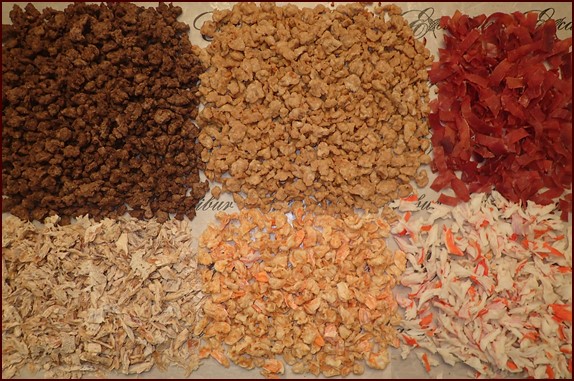
On this page I cover how to dehydrate:
Basis Beef
Ham
Shrimp
Tuna
Imitation Crab Meat
I continue with how to dehydrate chicken in the adjacent section.
Before we get into how to dehydrate meat, permit's cover a question I often receive near dehydrating meat...
How Long will Dried Meat Keep?
Freezing dried meat will preserve it for several years.
Vacuum sealing the dried meat prior to freezing prevents freezer burn down and freezing stops the clock for all biological processes.
For use and storage less than a year, freezing is not required, but is even so beneficial earlier yous get together your meals – provided you take reasonable care in drying and packing it:
Safely Dehydrating Meat
Dry out but lean meats and blot off any oil during the drying process. It is the fat in meat that can turn rancid as information technology reacts over time with oxygen. Estrus and lite advance oxidation, so store in a closet away from heat.
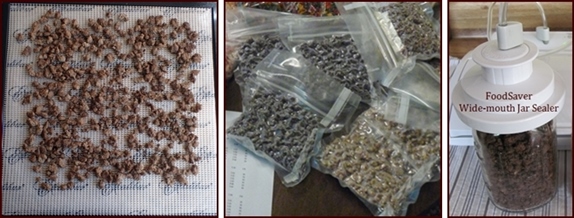
Storing Dehydrated Meat
Equally long as the meat yous dry is low-fat, it will keep well in jars with oxygen absorbers or in jars that are vacuum sealed with the FoodSaver accessory. I have stored dehydrated meat for upwardly to a yr in jars. If you lot want to go longer than a twelvemonth, or if you lot just want peace of mind, you can vacuum seal the stale meat in vacuum numberless, and place the meat in the freezer. When taking dried food out of the freezer, let the food to return to room temperature earlier opening the purse. Otherwise, condensation may form on the food.
See the section on vacuum sealing nutrient for more information.
Dehydrating Meat: Ground Beef
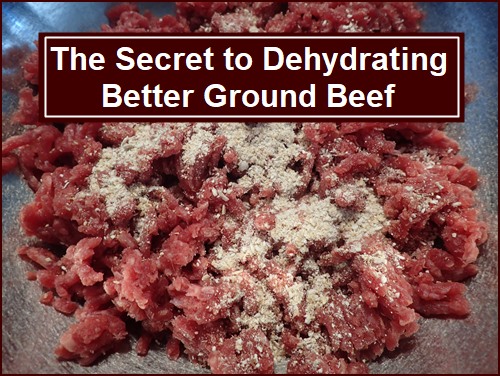
Backpackers frequently call dehydrated ground beef "gravel" because information technology doesn't rehydrate well. Solve this problem by adding breadcrumbs to the meat before cooking it. Breadcrumbs allow more liquid to penetrate the dried meat when you lot rehydrate it, then it turns out tender every time.
If you are sensitve to gluten in breadcrumbs, you can substitute ground oats or millet to prep the ground beefiness. Learn how in this Trail Bytes article.
Apply only lean or extra lean footing beef with fat content in the seven% to 15% range. Basis beef with 15% fat content is ofttimes labeled as Footing Round. Ground beef labeled equally Chuck or Hamburger volition have higher fatty content. Grass fed beef is usually in the vii% to 10% range.
Some of the fat in the basis beefiness gets removed when yous cook it. Some fatty chaplet upwardly on the surface of the meat while drying. Blot off the fat from the meat with paper towels afterwards cooking and a couple of times while it dries. Starting with low fat meat and blotting off what you can during cooking and drying will minimize any risk of the meat spoiling later on it is stale.
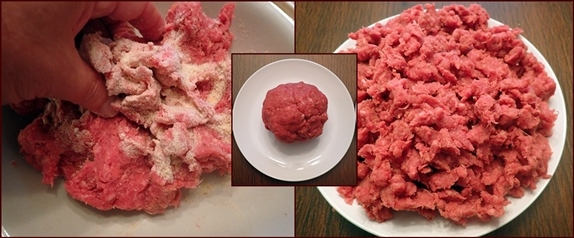
For each pound of beefiness, sprinkle ½ loving cup of finely ground breadcrumbs over the meat. Piece of work the bread crumbs into the raw meat with your fingers. Brand breadcrumbs past dehydrating bread slices for two to three hours so grinding the dried bread in a food processor. After working the breadcrumbs into the ground beefiness, form the meat into a ball and ready aside for a few minutes.
Interruption the meat into small pieces and cook in a frying pan over medium loftier heat until lightly browned and fully cooked, stirring continuously. Remove from heat and squeeze between newspaper towels to remove moisture.
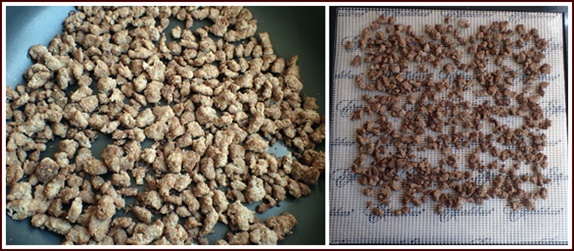
Spread small pieces of ground beef on dehydrator trays with Excalibur Paraflexx® sheets under the mesh sheets.The non-stick sheets volition catch any pocket-size pieces of dried beef that fall through the mesh. With Nesco Dehydrators, use the clean-a-screen or fruit-roll trays.
Dry at 145° for approximately six hours. Ground beefiness volition be hard when dry.
Once or twice during the drying process, move the meat effectually and squeeze with a paper towel to remove oil. Wipe whatsoever oil off the non-stick sheets. Interruption whatsoever pieces of meat that are drying slower than the rest in half.
Dehydrating meat separately allows me to include it in a broad multifariousness of recipes which combine it with different starches (potatoes, rice and pasta) and vegetables.
You'll find the complete collection of recipes which include dehydrated meat in my volume, Recipes for Adventure .
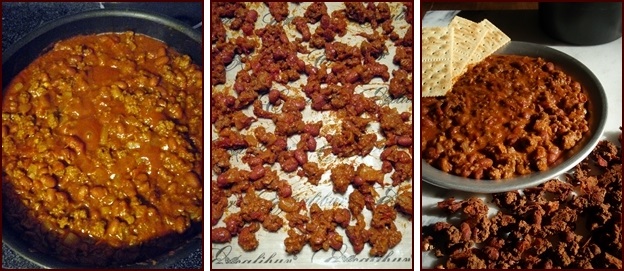
You can besides dehydrate meat in a complete meal. See Dehydrating Meat in Chili.
People write to me frequently to say how much they enjoy eating information technology on the trail.
Learn more about dehydrating meat in Chef Glenn's new volume, Recipes for Take chances Two: The Best of Trail Bytes
Topics include dehydrating meatloaf, meatballs, force per unit area cooked chicken, ground craven and turkey, shrimp tortillas, Canadian bacon bits, and more than.

Dehydrating Meat: Sliced Ham

Photo: Dried ham tastes great in Bean Bark Stew with Rice, one of the recipes in The Activity Guide: Dehydrating 31 Meals.
Choose lean precooked ham with fat content less than 10%. Deli ham sliced for sandwiches, about 1/16 of an inch thick, is good for dehydrating. Sliced roast beef or turkey may be dried also, but I mostly dry ham since roast beef is more than expensive.
Cut ham into ¾ to 1" broad strips and place on dehydrator trays. Dry out at 145° for approximately half dozen hours.
Blot off oil droplets that form on the surface of the meat with paper towels a couple of times while drying.
When the meat is completely dry, suspension the strips into smaller pieces for use in recipes.
Dehydrated ham remains a piffling chewy in meals, but I like the variety it adds to recipes such as Ham & Cheese Macaroni. Letting the meal boil for two minutes helps soften it up.
Dehydrating Meat: Seafood
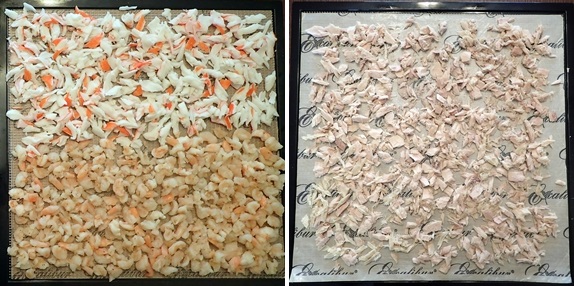
Photo: Imitation crab, shrimp, and tuna on dehydrator trays.
Dehydrating meat from the ocean will add many menu options to your backpacking trips.
Dehydrating Shrimp
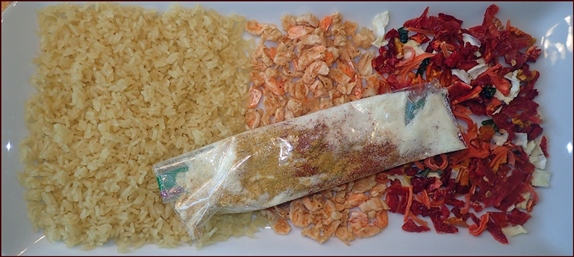
Photo: Curry Shrimp & Rice
To salvage time, buy frozen, precooked and peeled, medium shrimp. Small shrimp become lost in meals. Large shrimp tin can be used, simply the medium size divides well into pieces for dehydrating.
Thaw shrimp in refrigerator or ice common cold water. Compression off the tails and rinse.
Slice each shrimp into iv or five pieces, arrange in a single layer on dehydrator tray, and dehydrate at 145° for approximately six hours until hard. There should exist no moisture remaining when you cutting a slice in half.
Dehydrating Tuna
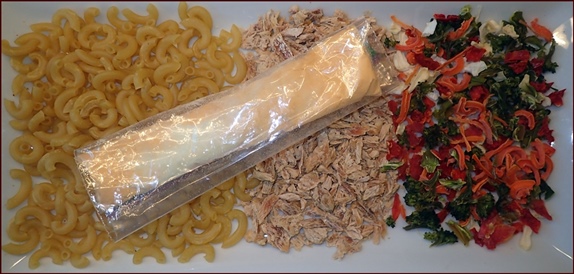
Photo: Tuna Mac & Cheese with Vegetables.
Apply Solid White Tuna packed in h2o. Fattier varieties of tuna and tuna packed in oil may spoil.
Bleed off the water into your dog'southward bowl. Pause the tuna up into small pieces and spread out in a single layer on the dehydrator tray. Excalibur mesh sheets keep all but the tiniest crumbs from falling through, so I don't use non-stick sheets. But y'all certainly tin can use them.
Dehydrate at 145° for approximately 6 hours until crispy. Drying tuna volition stink upwards your business firm.
Dehydrating Fake Crab
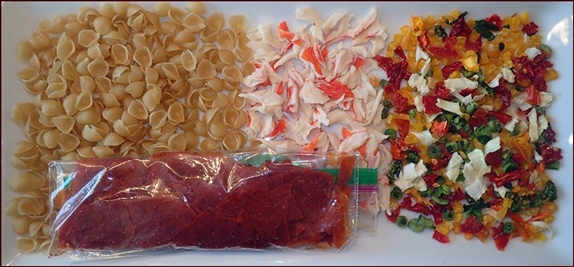
Photograph: Shells with Crab & Vegetables in Marinara Sauce.
Fake crab meat usually comes refrigerated, not frozen, in a vacuum pack.
Pull the meat apart into smaller pieces and dry at 145° for approximately six hours until hard.
Dried imitation crab meat rehydrates well in meals.
| | Free e-volumeDwelling house & Trail An Introduction to Drying Food Includes important food drying tips and food dehydrator recipes you can use right away. Get the gratis due east-book |
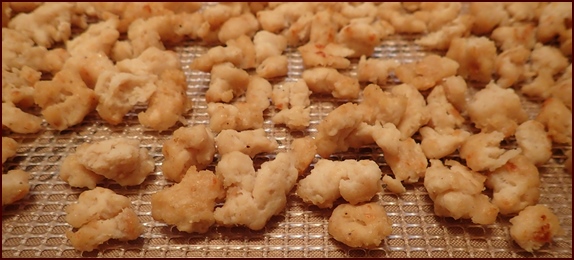
Continue Reading...
Next Topic: Dehydrating Craven
Dehydrated dwelling house-cooked chicken tin turn out tough as leather in your backpacking meals. Learn how to dehydrate chicken and then that it turns out tender every time.
Share this page with friends on social media.
Source: https://www.backpackingchef.com/dehydrating-meat.html

0 Response to "How to Dehydrate Cooked Beef Chuck Roast"
Post a Comment